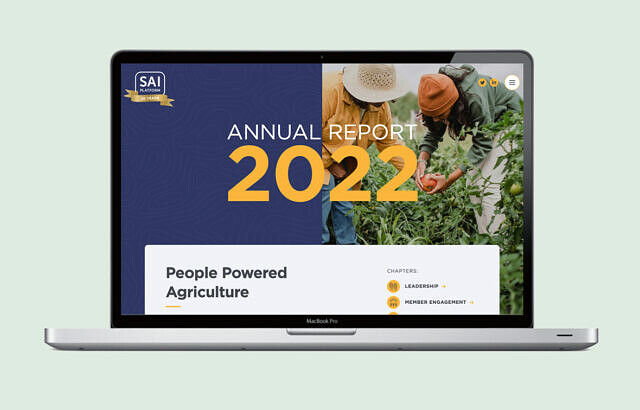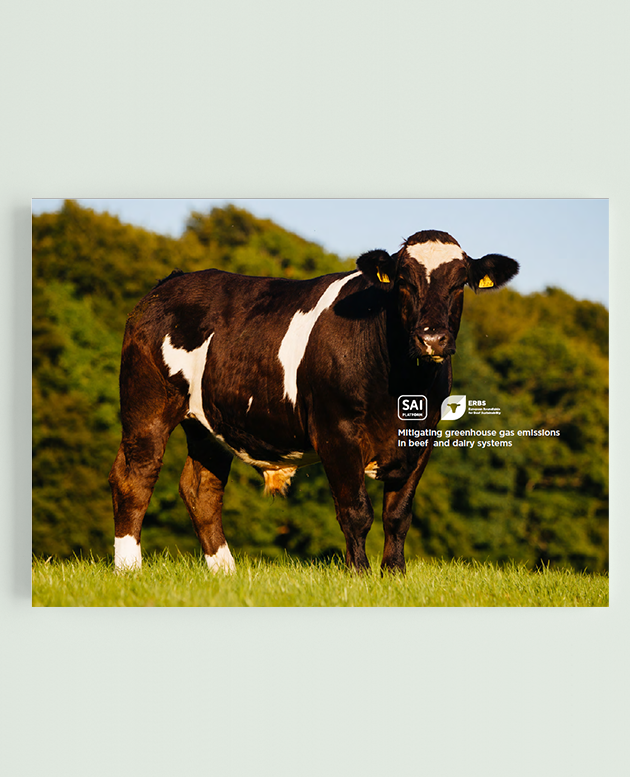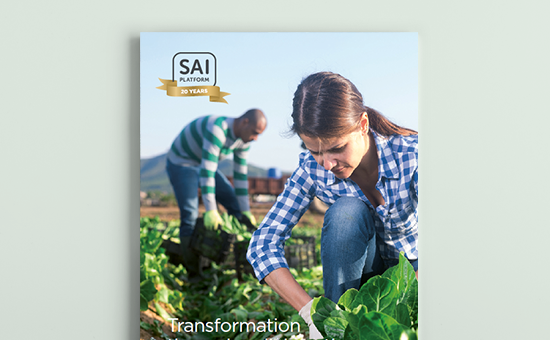Special Report on Climate Action: Agriculture as part of the solution to climate change
This report has been prepared by the Sustainable Agriculture Initiative Platform (SAI Platform) and includes input from members, participants and hosts along this learning journey in California.

California produces more than $50 billion USD of agricultural products every year. With more than 13 per cent of all US production, nearly half of the country’s fruits, nuts and vegetables come from California. The Central Valley region accounts for the vast majority of this production and grows some of the most diverse agricultural landscapes in the world. While leading the nation with almost 80 commodities it is also the sole producer of 14, including almonds and raisins. All of this amounts to an export value of over $20.56 billion USD every year.
Climate change vulnerability is one of the highest risks impacting this production. Vulnerability indices related to climate are the highest where these crops are most productive. In part, this is due to the water transport systems that have been integral to California’s leadership in agricultural production. Over 2/3 of precipitation falls in the north of the state, while 2/3 of the population live in the south. For the past 200 years, water transport, through canals and aqueducts, have enabled continual expansion of population in the south. As water transports through the Central Valley on its way, it is used to enable the productive landscape we see there today.

The California government realises the climate risks associated with the economic and environmental future of the state and is now a leader in climate emissions policy and strategy. This includes multiple policies and strategies, working across ecozones, demographics, and natural and working landscapes to build and scale up climate smart agriculture. Through the trifecta of alignment in state policies, financial incentives and technical assistance, California farmers have a very friendly environment to enact climate smart practices and further on-farm sustainability without the risks adherent to this type of innovation. Without the government support, technical assistance and the programmes of the California Department of Food and Agriculture (CDFA), the narrative of this learning journey would not be possible. This political and social climate is an important ingredient in the recipe for why the farmers and ranchers described in this report are able to move the needle and positively enact change on their lands.
UN Sustainable Development Goals: SDG #13

Goal 13: Climate action
The drastic effects of climate change are being experienced around the world. Global warming is causing long-lasting changes to our climate system, which threatens irreversible consequences if we do not act. The Intergovernmental Panel on Climate Change (IPCC) Fifth Assessment Report (AR5) concludes that climate change is unequivocal, and that human activities, particularly emissions of carbon dioxide, are very likely to be the dominant cause.
Changes are observed in all geographical regions: the atmosphere and oceans are warming, the extent and volume of snow and ice are diminishing, sea levels are rising and weather patterns are changing. Furthermore, climate change poses significant risks for the agricultural sector and for global food security. Resilience to the impact of a warming world will be enhanced by keeping the inevitable rise in average global temperature below certain key thresholds.
The annual average economic losses from climate-related disasters are in the hundreds of billions of dollars. This is not to mention the human impact of geo-physical disasters, which are 91% climate-related, and which between 1998 and 2017 killed 1.3 million people and have left 4.4 billion injured. The goal aims to mobilise US$100 billion annually by 2020 to address the needs of developing countries to both adapt to climate change and invest in low-carbon development. (United Nations Development Programme, 2018)
Supporting vulnerable regions will directly contribute not only to Goal 13 but also to the other SDGs. These actions must also go hand-in-hand with efforts to integrate disaster risk measures, sustainable natural resource management, and human security into national development strategies.
It is still possible, with strong political will, increased investment, and using existing technology, to limit the increase in global mean temperature to two degrees Celsius above pre-industrial levels, aiming at 1.5°C, but this requires urgent and ambitious collective action.
The Industry in particular therefore, needs to support farmers in attaining knowledge and access to new technologies and practices to adapt their production system, increase their resilience and ensure the continuity of their businesses for the future.

Climate impact in agriculture
Climate-related impacts are already reducing crop yields in some parts of the world. This trend is projected to continue as temperatures rise further. Crops affected include staples such as wheat, maize and rice. Climate change is projected to increase price volatility for agricultural commodities and reduce food quality.
Farmers can adapt to some changes, but there is a limit to what can be managed. Adaptive capacity is projected to exceed in regions closest to the equator should temperatures increase by 3°C or more. The agricultural industry’s own interests are best served by ambitious approaches to adaptation and to cutting emissions.
Greenhouse gas (GHG) emissions from agriculture were comprised of between 10–12% of man-made GHG emissions in 2010. The sector is the largest contributor of non-carbon dioxide (non-CO2) GHGs such as methane.
Opportunities for mitigation include reducing emissions. This includes use change, land management and livestock management. Carbon can be captured and stored in soil and biomass. Economy-wide emissions from energy use can be reduced, under certain conditions, by replacing fossil fuels with biofuels.
The potential for reducing GHG emissions from agriculture through changes in consumption could be substantially higher than technical mitigation options. Approaches include reducing food waste, changing diets towards less GHG-intensive food (e.g. substitution of animal products with plant-based food), and reducing overconsumption in regions where this is prevalent. (AR5, IPCC report)

With Climate Change already demonstrably impacting California, the SAI Platform Learning Journey visited 5 agri-businesses in the San Joaquin Valley and the Ogallala Aquifer in the High Plains region. Here participants saw first-hand how farmers are already adapting their business and implementing sustainable practices for the long-term. Practices in place centred on crop selection, water management and the use of on-farm technology. This on-the-ground learning experience provided new insights and showcased how farmers and companies can also adapt using these techniques in other geographical locations.
Thinking about water differently
Don Cameron, Terranova Ranch Inc.
In the early 1980s, Terranova Ranch began farming in Helm, CA. At that time, the prominent crops grown were upland cotton, alfalfa hay, wheat and barley. The first vineyards were planted in 1981 and in the late 1980s and 1990s the variety of crops increased to include corn silage, sugar beets and pima cotton.
In 1991 the ranch expanded by growing processing tomatoes with a little over 5,000 tons produced. The tomatoes were grown by planting seed and were furrow irrigated.
Today, Don Cameron uses transplants and subsurface drip irrigation for the 140,000 tons of tomatoes they grow each year.
In an attempt at further diversification, Cameron began farming organically with 15 acres in 1991. This has since expanded to over 600 acres in organic production today. The ranch continued to expand diversity of crops and cropping systems and by 2000, the ranch was growing over 25 different crops on 6,000 acres.
Since then, Cameron and his team have concentrated attention on implementing methods that keep soil, water and air quality as sustainable and healthy as possible. Using techniques that include water recharge, irrigation efficiency, energy conservation and energy production along with cleaner emission farm equipment, Cameron’s end-goal is to maintain long-term viability with adequate water, clean air and healthy soil. This is done through three key pillars: water recharge, green energy production and ecosystem services.
Water Recharge
Terranova Ranch has pioneered the concept of on-farm water recharge in California. For over 25 years, they have used irrigation and water conservation technologies and methods typically only used for watering crops but also recharging their below-ground aquifer.
In 2011, flood water was applied to farm fields and documented by researchers at UC Davis. In 2012, the Kings River Conservation District (KRCD) was granted $5 million from the California Department of Water Resources along with $2 million in matching funds from Terranova Ranch to build infrastructure to capture and distribute floodwater to Terranova and nearby farmland for on-farm recharge. Sustainable Conservation and UC Davis have been partners in this project.
The ranch can recharge up to a 1,000-acre feet of floodwater per day demonstrating Terranova’s commitment to long-term sustainability goals for farming in the San Joaquín Valley.
Green Energy
Sustainable farming practices and further reduction of carbon use in our society hinges upon implementing green energy methods that allow a substitute for fossil fuels for cleaner energy. Terranova Ranch currently generates a 2-megawatt solar facility. Renewable energy provides one third of the farm’s electric needs, while reducing greenhouse gas emissions by 3,700 tons CO² per year.
The ranch also approaches energy conservation as a key priority; the use of Variable Frequency Drives (VFD’s) reduces the amount of energy needed for the pumping of water. All pumps equipped with VFD’s require only the amount of energy needed for the water volume desired. This is a much-needed improvement from the old practice of running a pump at full power even when unnecessary.
Ecosystem Services
When you step onto Terranova Ranch, it’s evident that biodiversity and wildlife is important. With several wildlife refugia ponds and sanctuaries, there is an abundance of bird and insect life present.
Wildlife helps Terranova by providing necessary pest control and contributes to the diversity of the environment. Terranova has partnered with the Audubon Society to promote habitat for wildlife by placing owl boxes throughout the fields. In addition to the habitat the fields and orchards provide, Cameron maintains a 4-acre wildlife refuge that is a home to egret and cormorant rookeries, pond turtles, frogs, ducks, great blue herons, hawks, short eared owls and other wildlife.
Technology as enabler
E&J Gallo Winery

Enabling new technologies to optimise production with as little input as is necessary is key to the production of Gallo wine grapes. By implementing Variable Rate Drip Irrigation (VRDI) technology across the field, agronomists can increase yield in low vigour or low yielding areas, while decreasing overall water use. By creating a more granular map of the field, water use can be maximised in the zones where it is most needed.
The VRDI system can be used to irrigate each zone according to age of planting or crop requirement, additionally, it can be used to apply more water to low rigor areas to increase vine size and decrease product variability.
This site very clearly demonstrates successful implementation of decreasing yield variability, decreased plant stress and improved water conservation when implemented at the field-level.

When it comes to growing feed for his cows, Mike De Jager has been an early adopter of technology that increases the number of crops grown by limiting water consumption. Seven years ago, De Jager began experimenting with drip irrigation on his alfalfa and corn. Since moving to drip irrigation on his crops, De Jager has seen a 25% reduction in water use, with a 20-25% increase in crop yield.

“Farmers are very focused on taking care of the one resource we can’t make, and that’s water,” De Jager commented.
“There’s the perception that dairies use a lot of water, but in reality, there is not a drop of water wasted on our dairy, as we recapture and reuse as much water as possible.”
De Jager is partnering with non-profit Sustainable Conservation and Netafim on a pilot project to use dairy lagoon water to irrigate crops at his farm through a sub-surface drip tape application. De Jager’s is one of the first farms in California to experiment with this type of recycled irrigation technology. This project remains in the experimental stage.
Improving labour efficiency
Bonipak

As the population continues to grow and as water availability continues to decrease, technology is crucial for Bonipak. For over 85 years, Bonipak has been growing fresh vegetables all year round that include cauliflower, broccoli, celery, Brussels sprouts and romaine lettuce along with new crops being added like strawberries. Based in Santa Maria, California, Bonipak is always looking at new technologies to improve operations through automation and efficiency and be able to get the most out of the land and resources allotted to them.
Bonipak initially looked “to improve our irrigation consistencies from ranch to ranch,” says Anthony Reade, Production Supervisor at Bonipak.
“One of the major issues that we’re facing right now is the rising cost of labour and that’s what’s pushing us towards new options.”
Like many growers in California, Bonipak has faced labour shortages. By automating mundane and repetitive irrigation tasks, workers can move to other activities across the farm.

technologies at Bonipak field
Bonipak uses various precision irrigation technologies, including Netafim’s ReGen, a recyclable dripline that significantly improves yield and water efficiency while also reducing labour needs. Soil moisture sensors were installed to monitor conditions and automatically trigger irrigation events based upon the field-based information collected. As Reade states, “technology is allowing us to do more with less. In my short time in the industry, I’ve already seen so many ways in which technology can help us to limit redundant work, improve our efficiencies from the office to the field as well as analyse our business more precisely and completely.”
Wolff Winery
Wolff Vineyards is located on 125 acres of ecologically friendly property close to downtown San Luis Obispo. The property is 4.5 miles from the Pacific Ocean, providing the vineyard with a cool coastal marine influence. Present owners Jean-Pierre and Elke Wolff are committed to maintaining and improving the ecology of the vineyard.
The Wolffs have taken significant steps to advance the sustainable winegrowing practices on their farm, including soil management, integrated pest management, water management and conservation as well as energy conservation. Utilising cover crops, organic soil amendments and integrated pest management, they use the positive point system developed by the Central Coast Vineyards Team to continuously improve their sustainable wine growing practices.
Ecologically, they advance practices for climate change mitigation by enabling refugia that is communalistic with their pest management: natural habitat conservation and restoration: the first part includes quail, kestrel, red-tail hawk and barn owl.
The Wolffs have also participated in a long-term project for fish habitat restoration in two boundary creeks running to Pismo Beach. This fish habitat restoration programme includes erosion control, re-vegetation, shading, riparians repairs, bio-engineering alternatives, ground water percolation improvements. Working closely with the Natural Resources and Conservation Services, Department of Fish and Game, Water Resources Control Board, Army Corp of Engineers, National Marine Fisheries, and the Central Coast Salmon Enhancement society, the Wolffs are enabling natural resources to mitigate climate change on their farm, while also taking advantage of the predatory birds (as pest management) and water availability to use in their above-ground and below-ground drip irrigation agriculture.
The farm has also built multiple local collaborations for mutual benefit: supporting new research projects benefitting their agronomic practices as well as the environment through volunteering their vineyard as a testing station for projects such as “Beneficial Insect Release” in cooperation with the University of California Davis and California Polytechnic State University.
The Wolffs also have a beta site for a new type of electronic soil moisture sensors. Each of these collaborations and activities alone help to mitigate and adapt their vineyard to the ongoing onslaught of climate change, though when done in collaboration and across multiple networks, the Wolffs are building awareness and act as leaders in their community to further the sustainability of their collaborative interests.
Key findings

Mechanisms have been built to transport water through the Central Valley. Agriculture in California relies on this as two-thirds of rainwater lands in the north, yet two-thirds of the population lives in south.
Climate change is increasingly adding stress on these systems, as does technology. New technology installations require the up scaling of old systems while retro fits can be a challenge when addressing efficiency and scale. Depending on the crop, new technologies, like drip irrigation, can increase yield by up to 30% while decreasing inputs by up to 70%. However, to put new technology into place, the infrastructure must be modified accordingly to handle the new stresses and requirements of the system as well as the need to have sufficient finances to effectively scale the solution.
Progressive government policies to mitigate and adapt to climate change have forced the industry to be more innovative. Water is used in a way that continues to meet policy requirements, but also enables ongoing profitability for the agricultural sector in the Central Valley.
SAI Platform’s Farm Sustainability Assessment (FSA) is being embedded in several grower programmes, including the California Almond Sustainability Program (CASP). Here the FSA is enabling the industry to communicate the ongoing sustainability work they are doing and implementing to adapt, not only irrigation and fertigation systems, but also social and other environmental practices.
Adapting and helping to mitigate climate change includes taking action along all aspects of production. This includes all production systems, from water management, to orchard recycling, to nutrient and feed optimisation. Participants in the Learning Journey observed all of these, while building their network with likeminded sustainability professionals across the food and beverage industry.


